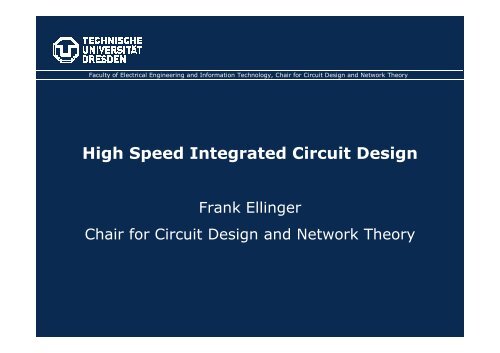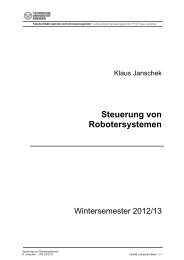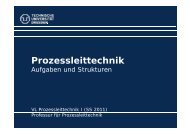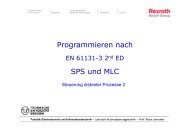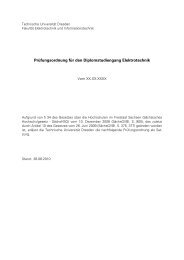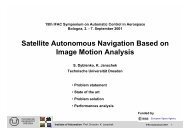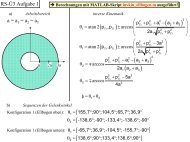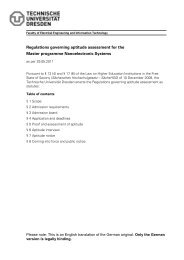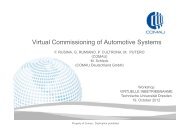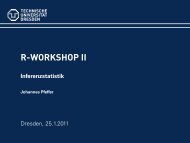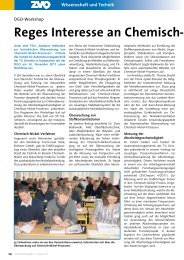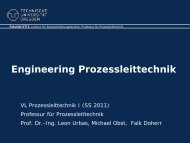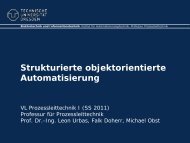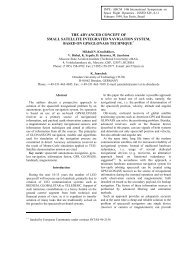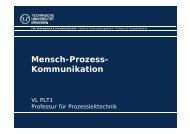High Speed Integrated Circuit Design
High Speed Integrated Circuit Design
High Speed Integrated Circuit Design
Create successful ePaper yourself
Turn your PDF publications into a flip-book with our unique Google optimized e-Paper software.
Faculty of Electrical Engineering and Information Technology, Chair for <strong>Circuit</strong> <strong>Design</strong> and Network Theory<br />
<strong>High</strong> <strong>Speed</strong> <strong>Integrated</strong> <strong>Circuit</strong> <strong>Design</strong><br />
Frank Ellinger<br />
Chair for <strong>Circuit</strong> <strong>Design</strong> and Network Theory
Outline<br />
1. Adaptive antenna combining IC systems<br />
2. Smart power amplifier IC systems<br />
3. Local positioning RFICs and systems<br />
4. <strong>High</strong> speed 60 GHz WLAN<br />
5. <strong>High</strong> speed optical ICs<br />
Chair for <strong>Circuit</strong> <strong>Design</strong> and Network Theory, F. Ellinger<br />
6. Beyond Moore nano-electronic circuit design<br />
7. Some facts<br />
8. Conclusions
1. Adaptive Antenna Combining in RF<br />
Pros<br />
☺ Only 1 IF/BB path<br />
⇒ small size, power<br />
consumption and costs<br />
☺ Easy system extension<br />
☺ Interferer<br />
cancelled prior to ADC<br />
⇒ Relaxed specs for ADC<br />
Challenges<br />
� Precise, compact, low-cost analogue<br />
phase & gain control ICs<br />
Avoid complex recursive adjustment:<br />
⇒ Phase control with min. impact on gain<br />
⇒ Gain control with min. impact on phase<br />
(focus of this talk)<br />
Chair for <strong>Circuit</strong> <strong>Design</strong> and Network Theory, F. Ellinger
Example for Architecture<br />
• EU funded project MIMAX<br />
• Coordinated by our chair<br />
• 802.11a (C-band)<br />
Chair for <strong>Circuit</strong> <strong>Design</strong> and Network Theory, F. Ellinger
Example for a RX SoC Implementation<br />
Chair for <strong>Circuit</strong> <strong>Design</strong> and Network Theory, F. Ellinger<br />
• 4 x adaptive signal branches from RF down to baseband interface<br />
• Including digital circuits for amplitude and phase control<br />
• Low cost 250nm<br />
IHP CMOS<br />
• P DC ≈ 3.3V, 130mA<br />
☺ Rohde<br />
☺ Rohde<br />
& Schwarz<br />
EEEfCom<br />
Innovation<br />
Award 2009<br />
2.8 ×<br />
2.5<br />
mm 2
2. Class-F CMOS Power Amplifier<br />
for WPAN/LAN<br />
10pF<br />
V gs<br />
Input<br />
Matching, 9Ω<br />
Bias<br />
942pH<br />
3.4pF<br />
In<br />
V dd<br />
10pF<br />
L1<br />
774pH<br />
4.9pF<br />
Output Matching,<br />
Filter<br />
4.34pF<br />
54pH<br />
L2<br />
534pH<br />
180fF<br />
Out<br />
Chair for <strong>Circuit</strong> <strong>Design</strong> and Network Theory, F. Ellinger<br />
Ref. Tech. f V DD S 21 P 1dB Eff. @ P 1dB<br />
This work 0.18 CMOS 5.6GHz 1.9V 10dB 18.4dBm 50%<br />
Biondi,<br />
RFIC 03<br />
542pH<br />
1.66m<br />
723pH<br />
L3<br />
BiCMOS 5.2GHz 2.7V 13dB 18.2dBm 50%<br />
J. Carls, F. Ellinger, U. Jörges and Marko Krcmar, “<strong>High</strong>ly Efficient 5 GHz - 6 GHz Class-F Power Amplifier for Low Supply<br />
Voltages in 180 nm CMOS”, submitted in 2008 to Microwave Wireless Component Letters
Adaptive PA Power Control<br />
Chair for <strong>Circuit</strong> <strong>Design</strong> and Network Theory, F. Ellinger<br />
• BMBF projects CoolRepeaters and CoolBaseStations & internal<br />
• PAs have max. efficiency (P RF/P dc) only in saturation (at full output power)<br />
• Back-off = P out,sat/P out typically around 20dB, e.g. if terminal close to BS<br />
• Back-off → 1 e.g. by adaptively decreasing DC supply voltage<br />
• Transistor always in saturation where max efficiency possible<br />
Example Example Example for for GSM<br />
GSM<br />
Id<br />
Load-line<br />
Vds
Control Methods<br />
Envelope tracking<br />
• Power known in baseband (BB)<br />
• Slow dynamics due to delays between BB ⇔ PA<br />
• Moderate efficiency improvement possible<br />
• Demonstrated for GSM<br />
Envelope following<br />
• Supply voltage directly follows envelope<br />
• <strong>High</strong>er efficiency improvement possible<br />
• Very fast control dynamics required<br />
• Full control in analogue to maximize speed & BW<br />
• No baseband connection required<br />
Chair for <strong>Circuit</strong> <strong>Design</strong> and Network Theory, F. Ellinger<br />
DC<br />
DC<br />
t<br />
t
Envelope Following<br />
Chair for <strong>Circuit</strong> <strong>Design</strong> and Network Theory, F. Ellinger<br />
• Efficiency improvement depends on required dynamics/BW of standard<br />
• CMOS losses considered<br />
• SOA: dc generation by buck converter & saw tooth generator<br />
• Slow/lossy since periodic control over full duty cycle (several periods)<br />
Envelope<br />
detector<br />
Control Algorithms<br />
Vg<br />
DC-DC<br />
Converter<br />
Vd<br />
In PA Out<br />
Coupler<br />
Efficiency ciency enhancement<br />
enhancement<br />
3<br />
2.5<br />
2<br />
1.5<br />
1<br />
0.5<br />
Typical<br />
back-off<br />
BW<br />
0.2kHz<br />
5MHz<br />
20MHz<br />
F. Haßler, F. Ellinger and J. Carls (CCN), “Analysis of Buck-Converters for Efficiency Enhancements in<br />
Power Amplifiers for Wireless Communication”, best student paper award, IEEE IMOC 2007
<strong>Integrated</strong> Control System<br />
• No limiting conventional buck c. & saw tooth<br />
• Fast since non-periodic, goal-oriented control<br />
• <strong>Integrated</strong> in 0.18 µm CMOS (7WL)<br />
• Excl. PA and LC LP<br />
• V DC and I DC up to 3.3 V and 280 mA<br />
• Efficiency Efficiency Efficiency enhancement enhancement enhancement of of UMTS UMTS class-AB PA<br />
systems with factor > 2 over average back-off<br />
F. Haßler (CCN), internal report, publication pending<br />
Chair for <strong>Circuit</strong> <strong>Design</strong> and Network Theory, F. Ellinger<br />
Single chip, 0.16 mm 2
3. Local Positioning based on FMCW Radar<br />
Reconfigurable<br />
Systems for<br />
Mobile Local<br />
Communication<br />
and Positioning<br />
CCN:<br />
• Coordination<br />
• 5.8GHz 7WL RF<br />
transmitter/PA design<br />
Coverage Coverage range [m]<br />
• 24GHz 7WL fractional-n<br />
synthesizer<br />
0.1 1 10 100 1k 10k<br />
Outdoor<br />
global<br />
Outdoor Outdoor<br />
local<br />
Indoor<br />
Automation<br />
Enhanced guiding<br />
Augmented reality<br />
RESOLUTION<br />
FMCW +<br />
WLAN<br />
Chair for <strong>Circuit</strong> <strong>Design</strong> and Network Theory, F. Ellinger<br />
Tracking<br />
Routing<br />
Guiding<br />
Positioning + mobile communication<br />
Pulse+<br />
UWB<br />
GPS +<br />
Galileo<br />
DGPS<br />
GSM/3G<br />
Field-strength +<br />
WLAN, Bluetooth<br />
Cell ID +<br />
GSM/3G<br />
0.1 0.3 1 10 30 100 1k 3k<br />
Positioning accuracy [m]<br />
F. Ellinger, R. Eickhoff, et. al., "Local Positioning for Wireless Sensor Networks", IEEE GLOBECOM, Nov. 2007
Partners<br />
www.ife.ee.ethz.ch/RESOLUTION/<br />
Chair for <strong>Circuit</strong> <strong>Design</strong> and Network Theory, F. Ellinger
Smart Factories<br />
DUT Transponder<br />
Chair for <strong>Circuit</strong> <strong>Design</strong> and Network Theory, F. Ellinger<br />
•<br />
• 3-D accuracy 50 Mio. €
Interactive Guiding<br />
Chair for <strong>Circuit</strong> <strong>Design</strong> and Network Theory, F. Ellinger<br />
•<br />
• 3-D accuracy
2-D Measurements (3-D similar)<br />
Xenia Xenia Forum Forum at at Siemens Siemens<br />
Siemens<br />
RESOLUTION<br />
Chair for <strong>Circuit</strong> <strong>Design</strong> and Network Theory, F. Ellinger<br />
UWB<br />
F. Ellinger et. al.,<br />
EU Project<br />
RESOLUTION-<br />
Local Positioning<br />
Systems based on<br />
Novel FMCW<br />
Radar, IEEE IMOC<br />
2007<br />
Old spec.** New spec.***<br />
Verified coverage 800m² « 400m² ?<br />
Accuracy 4cm* - 18cm 15-30cm ?<br />
Bandwidth < 150 MHz 1600 MHz 2500 MHz<br />
EIRP < 14dBm < -12dBm «-12dBm<br />
* Anechoic chamber ** Ubisense product *** EU decision<br />
⇒ FMCW competitive approach, e.g. compared to UWB
4. WLAN Data <strong>Speed</strong> Roadmap<br />
10G<br />
1G<br />
100M<br />
10M<br />
1M<br />
100K<br />
10K<br />
GPRS<br />
10x<br />
USB2.0<br />
100x<br />
802.11a<br />
UWB<br />
EDGE<br />
10G Ethernet<br />
802.11n<br />
HSDPA<br />
Chair for <strong>Circuit</strong> <strong>Design</strong> and Network Theory, F. Ellinger<br />
Short links<br />
LAN<br />
Cellular / WAN<br />
1995 2000 2005 2010 2015<br />
Source: G. Fettweis, “WIGWAM: System Concept for 1 Gbit/s and Beyond”,<br />
IEEE 802 Plenary Meeting, Nov. 2005
60 GHz SiGe Power Amplifier<br />
<strong>High</strong>est PAE of 22% in Silicon<br />
Chair for <strong>Circuit</strong> <strong>Design</strong> and Network Theory, F. Ellinger<br />
M. Hellfeld and F. Ellinger, “Universal Millimeter Wave Power Amplifier <strong>Design</strong> Method<br />
verified at 60 GHz in SiGe”, submitted to IET Journal on <strong>Circuit</strong>s, Devices and Systems
60 GHz SiGe VGLNA<br />
OVERVIEW OF RECENT V- AND W-BAND LNA DESIGNS<br />
Chair for <strong>Circuit</strong> <strong>Design</strong> and Network Theory, F. Ellinger<br />
This work [1] [2] [3] [4] [5]<br />
Process fT / 190 GHz / 180 GHz / 190 GHz / 200 GHz / 200 GHz / 200 GHz /<br />
active devices SiGe-HBTs SiGe-HBTs SiGe-HBTs SiGe-HBTs SiGe-HBTs SiGe-HBTs<br />
Peak gain<br />
frequency f0 63.5 GHz 60 GHz 79 GHz 59 GHz 61.5 GHz 79 GHz<br />
|S21| at f0 21.4 dB 18 dB 16 dB 14.5 dB 14.7 dB 21.7 dB<br />
NF at f0 6.0 dB 6.8 dB n/a 5 dB 4.5 dB 10.2 dB<br />
DC power 7.3 mW 66 mW 90 mW 8.1 mW 10.8 mW 105 mW<br />
Remarks variable gain differential differential<br />
<strong>High</strong>est gain vs dc<br />
power in silicon<br />
S. Hauptmann, F. Ellinger, et. al, “V-Band Variable Gain Amplifier<br />
applying Efficient <strong>Design</strong> Methodology with Scalable Transmission<br />
Lines”, IET Journal on <strong>Circuit</strong>s, Devices and Systems, 2010
60 GHz SiGe VCO<br />
Ω<br />
50<br />
T 1<br />
Chair for <strong>Circuit</strong> <strong>Design</strong> and Network Theory, F. Ellinger<br />
C block<br />
tline<br />
(L e )<br />
tline<br />
(L b )<br />
C 1<br />
C var<br />
Matching<br />
R<br />
V cc<br />
bias<br />
V tune<br />
I bias<br />
tline<br />
(L b )<br />
C 1<br />
Cvar<br />
tline<br />
(L e )<br />
C block<br />
Lowest phase noise with such a<br />
wide frequency tuning range in<br />
Silicon<br />
A. Barghouthi, F. Ellinger et. al, “<strong>Design</strong> of a 54 to 63 GHz Differential Common Collector SiGe<br />
Colpitts VCO”, International Conf. on Microwaves, Radar, and Wireless Communications, 2010<br />
R<br />
T 2<br />
Ω<br />
50
5. <strong>High</strong> <strong>Speed</strong> ICs for Optical Communication<br />
Receiver<br />
Photodiode<br />
Transmitter<br />
MUX<br />
N:1<br />
MOD<br />
LWL<br />
Chair for <strong>Circuit</strong> <strong>Design</strong> and Network Theory, F. Ellinger<br />
Laserdiode<br />
TIA LA CDR<br />
DEMUX DEMUX<br />
1:N 1:N
SiGe Broadband Amplifier for 80 Gb/s<br />
State-of-the-Art T-Coil Peaking<br />
• 30-50% BW enhancement<br />
• Limitation by S 22 degradation<br />
C. Knochenhauer and F.<br />
Ellinger, “A Comparative<br />
Analysis of Peaking Methods<br />
for Output Stages of<br />
Broadband Amplifiers”,<br />
sub. IEEE TCAS I<br />
C. Knochenhauer and F.<br />
Ellinger, “On the<br />
Effectiveness of Inductive<br />
Peaking”, sub. IEEE TCAS I<br />
Our Novel Approach<br />
• 200 % BW enhancement<br />
• Much less S 22 degradation<br />
Chair for <strong>Circuit</strong> <strong>Design</strong> and Network Theory, F. Ellinger<br />
T-Coil<br />
Chip Photo<br />
0.55 × 0.65 mm 2
SiGe Broadband Amplifier for 80 Gb/s<br />
Chair for <strong>Circuit</strong> <strong>Design</strong> and Network Theory, F. Ellinger<br />
Transmission Gain 50 Ω Output Matching Measurement<br />
at 55 G/s<br />
• highest rate of<br />
our test set<br />
Comparison with State of the Art SiGe Amps<br />
• Simulation up<br />
to 80 GB/s
40 Gb/s SiGe TIA<br />
Reference Tech Z T /Ω B/GHz I n,in pA/√Hz P/mW<br />
Jin, JSSC 08 CMOS 350 31
40+ Gb/s Laser Driver<br />
Chair for <strong>Circuit</strong> <strong>Design</strong> and Network Theory, F. Ellinger<br />
C. Knochenhauer, S. Hauptmann, C. Scheytt, F. Ellinger, “A Compact, Low-Power 40 Gbit/s Differential Laser Driver in SiGe<br />
BiCMOS Technology”, European Microwave Conference, 2009
40 Gb/s Modulator Driver with<br />
Breakdown Voltage Doubler<br />
Chair for <strong>Circuit</strong> <strong>Design</strong> and Network Theory, F. Ellinger<br />
6Vpp<br />
(differential)<br />
C. Knochenhauer, C. Scheytt, F. Ellinger, “A Compact, Low-Power 40 Gbit/s Modulator Driver with 6 V Output Swing in SiGe<br />
BiCMOS, to be submitted to IEEE JSSC
7. Beyond Moore <strong>Circuit</strong> <strong>Design</strong><br />
Chair for <strong>Circuit</strong> <strong>Design</strong> and Network Theory, F. Ellinger<br />
Scaling is already dead but nobody noticed it had stopped<br />
breathing and its lips had turned blue<br />
B. Meyerson, IBM CTO, 2003<br />
⇒ <strong>Circuit</strong> R&D on “Beyond Moore” technologies started, e.g.:<br />
• CNT (simulation of CNT RF amplifier)<br />
• Organic/printed (simulation of organic audio amplifier)<br />
• Silicon Nano Wire (project proposal)
8. Conclusions<br />
Chair for <strong>Circuit</strong> <strong>Design</strong> and Network Theory, F. Ellinger<br />
● Core competence CCN: <strong>High</strong>-speed and low power<br />
consuming analogue/RF ICs and systems<br />
● Complete RFIC frontends and interfaces<br />
● Rigorously optimized circuit blocks: PAs, LNAs, mixers, VCOs,<br />
synthesizers, DC/DC converters, TIAs, drivers, (ADC/DAC), etc.<br />
● Specific research areas:<br />
- Adaptive antenna combining, RF MIMO and beamforming<br />
- Smart power amplifiers with high efficiency<br />
- Local positioning sensors based on FMCW radar<br />
- RFIC development 100 MHz - 220 GHz, up to 10 Gb/s<br />
- <strong>High</strong> speed ICs for optical data communication up to 80 Gb/s<br />
- Beyond Moore nano electronic circuit design (started)
Chair for <strong>Circuit</strong> <strong>Design</strong> and Network Theory, F. Ellinger<br />
10-Nov-10, 28/30
Chair for <strong>Circuit</strong> <strong>Design</strong> and Network Theory, F. Ellinger<br />
Dresden University of Technology<br />
thanks you for your attention!<br />
Dresden<br />
Frank.Ellinger@tu-dresden.de


